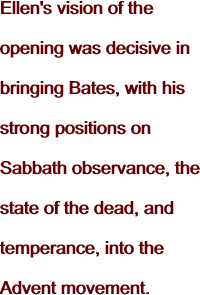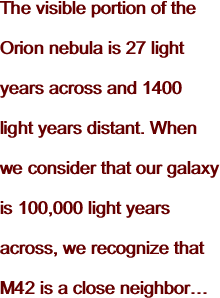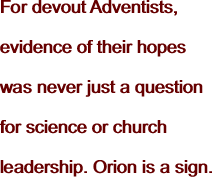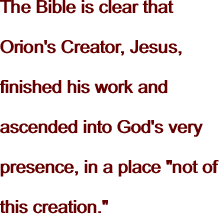 |
|
HOME | PROCLAMATION! MAGAZINE | DEVOTIONALS | STUDIES | LETTERS | ABOUT US | RELATED WEBSITES |
|
HOME / PROCLAMATION! MAGAZINE / 2009 / MAY/JUNE / CAREY
MAY/JUNE 2009
VOLUME 10, ISSUE 3
A R T I C L E S
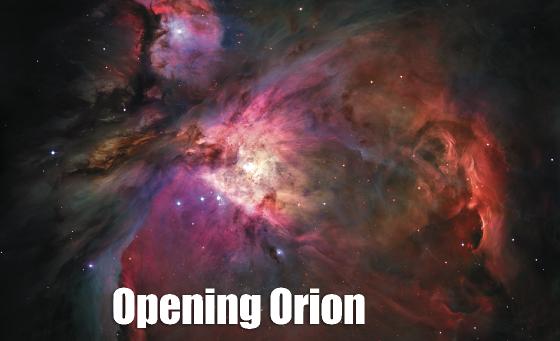
Martin Carey
"Can you show us the open space in Orion?"
The earnest question came from a young couple approaching the telescope in the dark. It was a crisp February night in the southwest desert where the sky looked black and the stars twinkled fiercely. Rigel and Betelgeuse, the stars at Orion's corners, shone brilliant white and orange. I swung the 20 inch telescope southward and centered on the giant's sword. Beautiful things are best when shared, and the Nebula of Orion is among the finest spectacles of nature.
The Great Nebula, also known as M42, appears to the naked eye as only a star, but the poet Tennyson captures its mysterious nature:
...A single misty star, Which is the second in a line of stars, That seem a sword beneath a belt of three, I never gazed upon it but I dreamt, Of some vast charm concluded in that star…1
Through a telescope one can see a cloudy mass that glows pastel green, sprinkled with tiny stars. A bright little square of stars, the Trapezium, shines at the center of the cloud. M42 is very popular among stargazers, and those who see it the first time often gasp with delight. Its enchanting beauty has inspired writers like G.P. Serviss to describe,
…stars apparently completed, shining like gems just dropped from the hand of the polisher, and around them are masses, eddies, currents and swirls of nebulous matter yet to be condensed…2
During my 40 years as an amateur astronomer, I have been impressed with the fascination Adventists have for Orion. The "opening" in Orion is an Adventist tradition that began in the earliest days of the movement and has become a symbol of Adventists' longings. No matter what science finds within the nebula, Adventists cherish a belief that Jesus will return through it. This belief shapes not only their eschatology but also impacts their unique identity. We will explore the origin of this belief and seek to understand why it persists.
Joseph Bates' Quest
Joseph Bates was an avid student of the stars, and as a retired sea captain had gazed at them from many remote places in the world. He was convicted in 1839 by the preaching of William Miller predicting Christ's coming and was among those disappointed in both 1843 and 1844 when Christ did not return. Trying to make sense out of Miller's failed prophecies, Bates searched for evidence that Christ's return was to be a literal appearance instead of a "spiritualized" one, as some taught.3 In May of 1846 he finished his tract called The Opening Heavens. Here he reasoned that the biblical references to heaven being opened (i.e. John 1:51 and Rev. 19:11) and to the New Jerusalem descending were referring to events that would occur in one location in the sky, the middle star of Orion's sword.
From what part of Heaven will this glorious City appear? We answer, from where the flaming sword is "guarding the way of the tree of life…" 4
Building his arguments, Bates quoted astronomer Christiaan Huygens, who in 1656 had described the "opening in the sky through which a brighter region was visible." For Bates, the region beyond must be the "heaven of heavens" streaming forth God's glory. Bates had read astronomer James Ferguson's descriptions of "cloudy stars" and how the "most remarkable of all the cloudy stars" is in Orion's sword, containing an opening into deeper space.5 He was convinced Huygens' "opening" was the gateway to heaven.
In November of 1846, five months after publishing his tract, Bates was invited to a conference with the newly married Ellen and James White in Topsham, Maine. Bates knew of Ellen's visions but questioned their authenticity. At this conference, he watched Ellen White in vision traveling to other planets and beyond. She described a "gap in the sky" of great beauty, framed by four stars appearing like gates, with bright glory shining through. Bates became very excited and exclaimed, "She is giving a more wonderful description than any astronomer ever dreamed of." 6
Because White had not demonstrated any knowledge of astronomy, Bates never suspected that the Whites might have read his tract. Hearing Ellen's glorious description of the gap, Bates was convinced that her visions were from God. He was so impressed, in fact, that he wished Lord Rosse, builder of the world's then-largest telescope, had been there to hear her. Bates believed that Rosse had seen the "gap" with his giant telescope, and he was certain that White's description would have deeply impressed him.7 Ellen's vision of the opening was decisive in bringing Bates, with his strong positions on Sabbath observance, the state of the dead, and temperance, into the Advent movement. The opening in Orion, therefore, had a role not only in shaping Adventist eschatology but also, even more profoundly, in gathering together its founders and fundamental beliefs.
A History of Openings
In 1321, Dante completed his sublime poem, The Divine Comedy, with vivid depictions of Purgatory, Heaven, and Inferno. Dante drew from classical sources such as Ptolemy and portrayed an elegant cosmology of celestial spheres. Earth lay at the center of the cosmos, while the planets and stars occupied the inner and middle spheres. The outermost sphere was called the Empyrean, the fiery realm of light, of heavenly beings, and of God.8
The Empyrean often appeared in other classics. In Milton's Paradise Lost, God orders Adam and Eve to
…multiply a Race of Worshippers holy and just: thrice happie if they know their happiness, and persevere upright. So sung they, and the Empyrean rung, with Halleluiahs: Thus was Sabbath kept.9
Thomas Aquinas and many church fathers taught that the Empyrean was the highest Heaven from which God's glory emanates. In their minds, God's universe was an ordered place of simple geometric forms where everything had its exact place, including God Himself. The spheres remained the dominant model for centuries until the models began to expand. Although today our universe doesn't resemble Dante's, we still find an echo of it when we sing, "all nature sings, and round me rings the music of the spheres."
In 1656, Christiaan Huygens, mathematician extraordinaire, observed the nebula of Orion and was intrigued with its luminous cloud. He perceived the appearance "of an opening in the sky through which a brighter region was visible."10 Huygens suspected he might have found a passage to deep space. For centuries, this single statement by Huygens influenced many astronomers' perceptions of Orion.
Natural philosopher and clergyman William Derham lived decades after Huygens and had a passion for science. He found more than one good use for a telescope. He was the first to accurately measure the speed of sound by observing the firing of cannon shots miles away and timing the arrival of the sound by the church clock. As an astronomer Derham had read of Huygens' "gap," and held that the "nebulose stars" were extremely distant objects beyond the "fixed stars." Nebulae are "Charms…openings into an immense Region of Light," Derham said in 1733.11 Religion and magic combined in this object.
The magic motif also appeared in the work of 19th century poet Alfred Tennyson. He has the sorcerer Merlin speak of a "charm" in the "single misty star:"
I never gazed upon it but I dreamt of some vast charm concluded in that star to make fame nothing.12
The notion of openings in the heavens returned one summer night in 1785 when William Herschel with his telescope discovered a dark patch among the stars by Scorpius. Dense star clouds surround this dark nebula, and the effect is striking. He exclaimed to Caroline, his sister, "Surely this is a hole in the heavens!"13 He was primed to perceive an "opening" that night; he had read Ferguson's mention of Orion's "gap", and he was acquainted with Huygens' opening.14 Moreover, he had compiled his own list of celestial "tubes". Herschel's interpretation of celestial "openings", however, was inverted from the interpretations of his predecessors. Instead of openings appearing brighter, Herschel believed that the open spaces appeared as darker regions among the stars.15 Joseph Bates would also follow this reversal of Huygen's perception.
Although he was devoutly Christian, Herschel was a man of science and did not look for charms or the Third Heaven, as Derham did. No bright empyrean had been sought or found. Europe's greatest astronomer, however, suspected that our Milky Way was not the limit. He believed that we live in a cosmos much grander than that of Dante.
Through Mirrors, Dimly
William Parsons of Ireland, the Third Earl of Rosse, had been building ever-larger telescopes to resolve the mysteries of the heavens. Lord Rosse had not only substantial means and manpower; he was a stellar engineer. Soon after completing an instrument with a 3 foot diameter mirror he started the construction of the "Leviathan of Parsonstown," the world's greatest telescope. So, in 1843, he and his servants began casting a three ton, 6 foot speculum metal mirror and a tube longer than a school bus to hold it.16
After many setbacks and a lengthy delay because of the Irish Potato Famine, Rosse finally had his 54 foot tall monster telescope ready for "first light", March 5th of 1845. It was easily the largest telescope in the world and would remain so for 72 years. He invited two astronomer friends from England, Sir James South and Dr. Thomas Robinson, to his castle for the telescope's "first light." According to records, Orion was a priority on their agenda. But when the wretched Irish weather finally cleared, Orion was out of the telescope's limited range, so they contented themselves with other nebulae.17
A detailed report of the telescope and its inaugural March 5th observing session appeared in the Times of London on April 16th, 1845, and in the Illustrated London Times three days later. In spite of his original intention, Rosse had not yet observed Orion; The Times report only states Rosse's desire to observe the nebula in the future. In fact, he was unable to view Orion until December of that year.18 Adventist writer J.N. Loughborough later claimed, however, that Lord Rosse had observed an Orion opening in early 1845.19
When Rosse did finally observe Orion, he wanted to settle a matter. Orion's nebula was the focus of an intense debate at that time, but it was not about openings. French mathematician Pierre-Simon Laplace, an avowed atheist, had published his nebular theory some years before. He proposed that stars and planets were formed by natural means from clouds of luminous fluid. When Napoleon had asked Laplace how God fit in, Laplace replied, "I had no need of that hypothesis."20 Although not atheists, the Herschels had also been favorable to the "luminous fluid" theory, while Rosse was opposed. Rosse believed that all the stars had already been created, that there were no clouds of luminous fluid but only completed stars.21
The unanswered question Rosse wanted to settle was this: was M42 a cloud of glowing fluid in near proximity, or was it an enormous star cloud too distant to resolve into individual stars? Lord Rosse and his friends had resolved many other nebulae into stars. If M42 could also be resolved, then the atheistic nebular hypothesis was refuted. Perhaps the Leviathan of Parsonstown could show proof of creation and settle the question.22
Finally, in March of 1846, Rosse saw additional stars in M42 and was certain that with a larger telescope, all its clouds would resolve into stars. Others "confirmed" this finding, and most accepted the doctrine that all nebulae were actually star systems.23 Moreover, Lord Rosse had defended the Creator's reputation.
Rosse's doctrine was swept away in 1864, however, when Huggins turned his spectroscope on M42 and found that its light revealed burning gas.24 With Leviathan, nevertheless, Rosse had made a monumental contribution. One of those cloudy objects he studied revealed a spiral shape, and Rosse recorded its graceful curves on paper. He had revealed beautiful M51, the "Whirlpool" galaxy.25 He couldn't know that it actually contains 100 billion stars, is 30 million light years away, and that there are 200 billion of these spirals out there. He had assumed that our single Milky Way spiral contained the entire universe.
As for Herschel's dark "tubes" into deeper space, E.E. Barnard later showed that those dark patches in the heavens are clouds of gas and dust which block the light of the stars behind them. Herschel's "hole in the heavens" near Scorpius is a "Barnard object."26
Rosse's theories had come to naught. He had been uncertain about openings in M42, and he was mistaken about its composition. With his drawing of a spiral galaxy, however, he gave the world a glimpse into the unknowable vastness of the cosmos. Best of all, the Creator whom Rosse had been trying to defend had carried out His own purposes. A rivalry, an atheist's theory, and an ink drawing all worked together to reveal the depth of the Creator's universe and to demonstrate that He remains in charge of His own reputation.
M42 and New Discoveries
The visible portion of the Orion nebula is 27 light years across and 1400 light years distant. When we consider that our galaxy is 100,000 light years across, we recognize that M42 is a close neighbor and is certainly not the center of the universe. It does, however, keep yielding more secrets. When NASA turned the Hubble telescope on M42 in 1991, we beheld new wonders called "proplyds," or proto-planetary systems. Scattered about the nebula like ripening fruit, these condensing blobs of gas display odd shapes, and some have stars glowing inside. Astronomers believe that these are solar systems in formation.27
Most of M42's gas is hydrogen, churned into swirls by the blast of stellar winds from the stars within the cloud. With today's telescopes we confirm there are no "Herschel tubes" visible—although the nebula presents a shallow concave face in our direction—and the dark region near the Trapezium is an opaque cloud obscuring the light from behind, not a deep cavern.28
Growing a Legend
Two years after that pivotal 1846 meeting with Joseph Bates, Ellen White related her vision of earth's last hours:
Dark, heavy clouds came up and clashed against each other. The atmosphere parted and rolled back; then we could look up through the open space in Orion, whence came the voice of God. The Holy City will come down through that open space.29
That quote would be repeated many times in Adventist publications, and it is the only statement White ever made regarding Orion's open space. Years later, she wrote of her 1846 meeting with Bates, but she said nothing regarding Orion.30 The story of the opening expanded in the telling and became part of Adventist lore through the writings of other Adventist authors. White, however, never confirmed or denied the stories.
In an 1886 article for The Review and Herald, J.N. Loughborough recounted the meeting between Bates and White, adding details about Orion's nebula and the Rosse telescope.31 White's Orion opening was now firmly identified with M42. In 1900, General Conference President O.C. Godsmark wrote that behind the clouds in Orion was God's throne:
As we view this wonder, we cannot but feel that God in his mercy is permitting us to see a little of the glory of that city above…32
The Adventists' Orion opening story would reach its apex in Dr. Lucas Reed's 1919 book, Astronomy and the Bible. Although by 1900 most astronomers had abandoned the theory of nebular openings, Adventist writers still looked for support in the science community. They found Dr. Edgar Larkin, director of Mount Lowe Observatory, and a dabbler in religions. Larkin saw in M42 "a deep opening, receding into the mighty distance beyond." The Seventh-day Adventist Southern California Conference office took notice and paid Larkin a visit in 1911. Dr. Larkin's articles and quotes were used in several Adventist publications, including Reed's 1919 book, in which he makes several errors in citing Larkin. However, for Reed, Orion was clearly the center of the universe.33
Shutting Orion
Through the 1960's, Adventist authors repeated Reed's ideas and contradictions in Adventist publications. In 1976, however, the The Review and Herald published an article by two Adventist scientists, Sprengel and Martz, critically examining the Orion opening story. They found that M42 does not show an opening into deeper space, nor is Orion the center of the universe. Further, they showed that the M42 opening idea was not based on Ellen White's statements but on Bates' beliefs. They concluded that the identity of the opening into heaven would become clear when Jesus appears.34
This worthy study missed the full significance of the Opening among Adventists. Although in its inception the Orion story drew support from the science of that time, the authority of Ellen White's single statement gave it lasting credence. It is possible that she later changed her mind; her single statement appears to refer to a known object, "the opening," not to "an opening" that could appear at the time of some future event. Since she never mentioned the Orion opening again, we don't know if she continued to believe in a specific opening in the nebula in spite of new evidence from science. Nevertheless, Adventist readers understand her statement to endorse an existing opening in Orion through which Jesus will return.
When science and The Review and Herald withdrew support from the opening, Ellen White's single authoritative statement remained. For devout Adventists, evidence of their hopes was never just a question for science or church leadership. Orion is a sign. Like Joseph Bates in 1846, they see within Orion's glow the hope of God's presence drawing near to bestow his favor. That is an opening that cannot be shut.
The Great Fool and the Little Heap
Orion is mentioned three times in the Bible, twice in Job and once in Amos. Each time it is mentioned with the Pleiades. Orion's name in Hebrew is Chesil (or Kciyl), "the Fool." 35 In the legends of Job's time, Orion was a proud giant who believed he could challenge God and instead showed himself a fool. In some Hebrew legends, he is Nimrod ("we shall rebel"), the proud founder of cities. Because of his arrogance, he was confined to his place in the firmament and destined to rotate with the seasons. Henceforth, Orion brought winter, which bound as with icy "cords" the land and the hands of men.36
The Pleiades are called Kimah, "The Heap," and are a little "heap" of stars in Taurus that emerge from behind the sun in spring, and are associated with the joy of that season. Orion and the Pleiades are apparently mentioned together in the Bible to contrast the seasons; the "sweet influences" of spring, vs. the frigid bonds of winter.37
Amos delivers the terrible message to Israel, "Prepare to meet your God!" (Amos 4:13). Judgment was coming—a judgment Israel neither expected nor feared. "Why would you have the day of the Lord? It is darkness, and not light!" (5:18). They served Sakkuth and Kiyyun, the star gods that they made for themselves (5:26). "He who made the Pleiades and Orion, who turns blackness into dawn and darkens day into night, the Lord is His name" (5:8). And yet—the One who rules the ordinances of heaven is coming with terrible judgment, yet he extends grace and pleads, "Seek me and live" (5:4).
God showed his majesty to his friend Job another way. After being smitten with calamity, Job sat outside in the dirt, scratching his boils and arguing with his friends about his innocence. Every night, the sight of Orion wheeling overhead would have been a cold reminder of his plight. He complains, "How can a man be in the right before God?" (Job 9:2). "He...who made the Bear and Orion, the Pleiades" (Job 9:9) is strong and wise beyond our understanding. "Behold, he snatches away, who can turn him back? Who will say to him, ‘What are you doing?'" (Job 9:12). Orion and the stars demonstrate to Job God's terrible wisdom and power. When he contemplates them, Job wishes to bring suit against the ultimate enemy, God. He demands a vindicator who can save him and hold God accountable. He desperately wants to see God in person.
Recently, a colleague saw me reading Job and said, "If that book is true, then God is unjust!" "Really," I said, "How so?" He said, "Well, think of all the innocent deaths of Job's family." My friend said with passion, "Someone's got to hold him accountable!" Job says in 19:25, "For I know that my redeemer lives, and at the last he will stand upon the earth." If God's frightening power needs checks and balances, a third party must save us from him. But who can fill the role of this "someone"?
After 32 chapters, Job argues his three friends into silence, for he is "righteous in his own eyes." Young Elihu ably defends God's goodness and majesty, but the real showdown arrives in a raging storm. Job now meets his Tormentor in person, and the judgment day he demanded has suddenly arrived.
"Who is this that darkens counsel by words without knowledge?" God was present the whole time while Job put him on trial. Now Job is quiet while God interrogates him.
"Can you bind the chains of the Pleiades or loose the cords of Orion?"
"Do you know the ordinances of the heavens?"
Do we? That is a good question for learned men of all times. Just what is gravity, and how about "dark energy" and "dark flow"? What preceded the Big Bang, if there was one? Tell us, if you have understanding. After all the accomplishments of modern astronomy, the composition of most of the universe eludes us.38 There is only One with the wisdom to create and to know the stars. "He upholds the universe by the word of his power" (Hebrews 1:3b).
God asks, "Will you condemn me that you may be in the right?" (Job 40:8b). In Chapter 42, Job finally sees his ignorance, that he has no legal standing to judge God. John Piper describes how Job comes to repentance:
"I know that you can do all things and that no purpose of yours can be thwarted…"(v. 2). Job submits to God's sovereignty.
"I have uttered what I did not understand, things too wonderful for me…"(v. 3b). Job submits to God's wisdom and his word.
"Now my eye sees you, I despise myself, and repent in dust and ashes" (v. 5b-6). Job repents of his demands and his pride.39 There can be no "checks and balances" on God. When he sees that his Tormentor and his Redeemer are one, he lays down his lawsuit, and he finds grace.
Where is Our Redeemer?
When we need hope and consolation, we long for God to show himself and make things right. Like Job, we yearn for an audience; "Oh, that I knew where I might find him, that I might come even to his seat! I would lay my case before him and fill my mouth with arguments" (Job 23:3,4).
Oh, how Joseph Bates and his friends wanted an audience, a manifestation of His presence! They looked for a sign from Him in the dim reflections of larger metal mirrors and newer prophecies. The opening in Orion, along with Ellen White's visions, gave them a sense of God's visitation.
Does God's throne have an address among the constellations? God sets his "glory above the heavens" (Ps. 8:1). King Solomon said, "Behold, heaven and the highest heaven cannot contain you…" (I Kings 8:27). He is near and far, as he declares in Jeremiah 23:23, "Am I a God at hand, declares the Lord, and not a God far away?"
Jesus, our Redeemer, has ascended above all the stars, for he "has passed through the heavens," and is "set apart from sinners, exalted above the heavens" (Heb. 4:14, 7:26). He appeared in the "more perfect tent (not made with hands, that is, not of this creation), he entered once for all into the holy places…" (Heb. 9:11). God's throne is too lofty to have coordinates on our celestial maps. He is not constrained by His universe, or anything in it.
Our Redeemer was exalted to the very presence of God and sat down at his right hand—because He was an equal, and because His atonement was finished. "For by a single offering He has perfected for all time those who are being sanctified." Since we have "such a high priest," we may boldly draw near the throne of grace (Heb. 4:16). In Christ we ascend, "even to His seat." We will always stand in His presence and will always be right with Him, "perfected," once for all. He has that kind of authority; His work is that complete. There is no greater glory than that which shines from God's right hand.
We don't need to gaze at Orion's sword nearby to find God's glory. Orion's gaseous clouds contain no hope of life. Our Hope dwells in a high and holy place, in eternity. Only because He is the lofty, overwhelming Sovereign can we believe His promises to keep us forever with His indwelling Spirit. The terrifying Creator of Orion is our Shepherd. "My sheep hear my voice, and I know them, and they follow me. I give them eternal life, and they will never perish, and no one will snatch them out of my hand…I and the Father are one" (Jn. 10:27-30).
Summary
God's total, unfathomable sovereignty over all creation is essential to our confidence in his saving power. The Bible is clear that Orion's Creator, Jesus, finished His work and ascended into God's very presence, in a place "not of this creation." There is no biblical evidence that he uses an Orion opening in his travels to earth. Additionally, the Orion opening concept has been abandoned by science. The questions arise: why did Ellen White endorse in vision the idea of a celestial opening, and why does this idea still persist among Adventists?
In retrospect it seems that Ellen White quoted in vision the words that she knew would be convincing to her listeners at that time. Her vision did help confirm her prophetic status in Joseph Bates' mind. Moreover, the notion of a visible site marking the gateway to heaven has made God seem more tangible and accessible. This idea also supports the shared paradigm of a "remnant church" that was given special knowledge of God's plans. Yet God cannot be reduced or contained by space; His dwelling and His return cannot be identified by a physical place. He is "set apart" above the heavens, and He dwells in the hearts of those who are born of the Spirit. He is farther than Orion, and nearer than our thoughts (Psalm 139:4).
Would you enter boldly into God's presence? Then draw near, friend, and lay down your weapons! Repent of your demands, and submit to His sovereign authority! Submit to His word without reservation. Like Job, we can have peace with our Sovereign, and see Him with our own eyes. †
References
- Tennyson, A.L. "Merlin and Vivien": http://www.lib.rochester.edu/camelot/idyl-m&v.htm
- Serviss, Geritt P. Quoted by Olcott, William T. in Star Lore of All Ages, p. 287, http://books.google.com/books?id=6_
IRAAAAYAAJ&pg=PA287&lpg=PA287&dq=GP+Serviss+%22stars+apparently+completed%22&source=bl&ots=xCtJUSGCu
S&sig=skc7o027JVdVswlN9wTYJ0nrqNE&hl=en&ei=vbgNSpuMHJritAOPqPCQ
Aw&sa=X&oi=book_result&ct=result&resnum=1 - Knight, George. Joseph Bates: The Real Founder of Seventh-day Adventism, p. 137,
http://books.google.com/books
?id=ZYAMxPZBXQYC&pg=PA137&lpg=PA137&dq=Joseph+Bates+%22The+Opening+Heavens%22&source=bl&ots=0sgGdq1pSF&sig=0V94x3ztv6mWyVcDV19mqwx6mPE&hl=en&ei=tL4NSu-6BaectgO_1unzAg
&sa=X&oi=book_result&ct=result&resnum=5 - Bates, Joseph. The Opening Heavens, p. 5, http://www.remnant-prophecy.com/adv-pioneer-lib/JBATES/OPENHEAV.pdf
- Ferguson, James. Astronomy Explained Upon Sir Isaac Newton's Principles, p. 355, http://books.google.com/books?id=tTygAAAAMAAJ&dq=Astronomy+explained+upon+Sir+James+Ferguson&printsec=frontcover&source=bl&ots=34gdYX_jF
6&sig=S67vEhXpD0aM9Pro9OJxM9pWpAQ&hl=en&ei=BwkS
SuudD42EtAPF66jqDQ&sa=X&oi=book_result&ct=result&resnum=2#PPA355,M1 - Spalding, A.W. Pioneer Stories of the Second Advent Message, pp. 198,199, http://books.google.com/books?id=ljjHY4hjV
0kC&dq=Pioneer+Stories+of+the+Second+Advent+Message,&printsec=frontcover&source=bl&ots=ltFyN1FoAx&sig=RMu
EWPio_3XnG3hDmYeSD1huCAw&hl=en&ei=XE0
SSoq9JYyItAO0rIjmDQ&sa=X&oi=book_result&ct=result&resnum=1#PPA198,M1 - Spalding, A.W. Captains of the Host, http://books.google.com/books?id=CzHLekI0PpEC&pg=PA131&lpg=PA131&dq=
Joseph+Bates+Lord+Rosse&source=bl&ots=9WatIhBKPp&sig=RCuVc3uF_lZ2mGI_BPrzBh6tl5E&hl=en&ei=-NcNSsrnJZG
CtgOtqcCFAw&sa=X&oi=book_result&ct=result&resnum=2 - PPA132,M1 - Hede, Jesper. Reading Dante,p. 176, http://books.google.com/books?id=15H_22-icq8C&pg=PA176&lpg=PA176&dq=Dante+
Ptolemy&source=bl&ots=BAUd_26Ibc&sig=3ljvEa1mRoCmJ8-NfZC1SAP2K4k&hl=en&ei=39oNSvnGLYWytgPHqtDpAg&sa=
X&oi=book_result&ct=result&resnum=2 - Milton, John. Paradise Lost, p. 64, http://books.google.com/books?id=hPzoiWyhBTgC&pg=PA64&lpg=PA64&dq=%22Emp
yrean+rung,+with+Halleluiahs%22&source=bl&ots=OOH81xzMCv&sig=bX9UJIXGszz-RAFMwq7YS-45JL0&hl=en&ei=R9w
NStO7HISotAPvvaD3Ag&sa=X&oi=book_result&ct=result&resnum=4 - SEDS, The Messier Catalog, M42 Observations and Descriptions, http://seds.lpl.arizona.edu/MESSIER/Mdes/dm042.html
- Derham, William. Observations of the Appearance among the Fix'd Stars, called Nebulous Stars, Phil. Trans. XXXVIII, 70 (1733),
http://messier.obspm.fr/xtra/similar/derham_pt.html - Tennyson, Alfred Lord. Merlin and Vivien, p. 388, http://books.google.com/books?id=v1VbAAAAMAAJ&pg=PA388&lpg=
PA388&dq=%E2%80%9CI+never+gazed+upon+it+but+I+dreamt%22&source=bl&ots=nMluCQAy5k&sig=IdwxdrP9wjUXg
RM-0uk-tYMT1VM&hl=en&ei=A-ENSrCWIKbqtAPFttTlAg&sa=X&oi=book_result&ct=result&resnum=1 - SEDS, The Messier Catalog, Friedrich Wilhelm Herschel, http://messier.obspm.fr/xtra/Bios/wherschel.html
- Ibid.
- Li, Aigen, and Greenberg, J. Mayo. In Dust We Trust, p. 2.1, http://nedwww.ipac.caltech.edu/levWilliam Herschel and holes in
the heavensel5/March02/Li/Li2.html#2.1 - Birr Castle Demesne, History of the Telescope, http://www.birrcastle.com/telescopeHistory.asp
- Hoskin, Michael. "The Leviathan of Parsonstown: Ambitions and Achievements," Journal for the History of Astronomy, 2002, p. 64,
http://www.shpltd.co.uk/hoskin-leviathan.pdf - The Earl of Rosse's Leviathan Telescope, Times of London, April 16, 1845, http://archive.timesonline.co.uk/tol/archive/
- Loughborough, J. N. The Great Second Advent Movement, p. 178, http://www.aceuk.org.uk/The_Great_Second_Advent_
Movement.pdf - Wikipedia, Pierre-Simon Laplace, http://en.wikipedia.org/wiki/Pierre-Simon_Laplace#Laplace_and_Napoleon
- Hoskin, Ibid.
- Ibid.
- Herschel, John F.W. Outlines of Astronomy, The National Quarterly Review, 1868, http://books.google.com/books?id=QCU
AAAAAYAAJ&dq=%22The+National+Quarterly+review%22+Rosse&printsec=frontcover&source=bl&ots=7Xx82QkELz&sig=8qF
j7SxuY2ATmXpXg1sXSdStfjk&hl=en&ei=NPcQSor5IJ
OotAOe1eT7Ag&sa=X&oi=book_result&ct=result&resnum=1#PPA95,M1 - King, Henry C. The History of the Telescope, p. 286, http://books.google.com/books?id=KAWwzHlDVksC&pg=PA285&lpg=PA285
&dq=Huggins+spectroscope&source=bl&ots=0GRN9cHRW5&sig=vNL8x0L8Bhs4B48ZYssMfvKoBPw&hl=en&ei=3fgQSpSgLqHy
tAOFpqWFAw&sa=X&oi=book_result&ct=result&resnum=2#PPA286,M1 - Hoskin, Ibid.
- Barnard, E.E. A Photographic Atlas of Selected Regions of the Milky Way, http://www.library.gatech.edu/barnard/
- Nemiroff, Robert, and Bonnell, Jerry. Astronomy Picture of the Day, NASA, http://apod.nasa.gov/apod/ap961017.html
- Wikipedia. The Orion Nebula, http://en.wikipedia.org/wiki/Messier_42
- White, Ellen G. Early Writings, p. 41, http://www.gilead.net/egw/books2/earlywritings/ewindex.html
- White, Ellen G. Life Sketches of James White and Ellen G. White (1880), p. 238, http://egwdatabase.whiteestate.org/nxt/gateway.d
ll?f=templates$fn=default.htm$vid=default - Loughborough, J.N. The Gap in the Sky, cited in Yigu, Kheon, Issues of the "Open Space in Orion" Presented in SDA Literature (1846-
1994), Sahmyook University, http://with.syu.ac.kr/aboard/pds/guid_atl_msl_res/Issues%20of%20The%20Open%20Space_(%EC%
9D%B4%EA%B5%AD%ED%97%8C).pdf - Yigu, Kheon. Ibid, p. 4, http://with.syu.ac.kr/aboard/pds/guid_atl_msl_res/Issues%20of%20The%20Open%20Space_(%EC%9D%B4
%EA%B5%AD%ED%97%8C).pdf - Ibid.
- Sprengel, Merton E., and Martz, Dowell E., Orion Revisited—3: Does the "Open Space" Exist Today? Review and Herald, April 8, 1976,
pp. 375-376. - Strong's Hebrew Dictionary, Kciyl, 3684, Biblos, http://strongsnumbers.com/hebrew/3684.htm
- Maunder, E. Walter. Astronomy in the Bible, p. 238, http://books.google.com/books?id=KNNxjzxutLwC&pg=PA238&lpg=PA238&dq=
orion+and+nimrod&source=bl&ots=gNVqBnqV97&sig=j9ryENjdt09Yf2HuEiNEdJTP8-U&hl=en&ei=7-wRStb0MIKEtAOTxKHoDQ&sa=X
&oi=book_result&ct=result&resnum=9 - Gill, John. Commentary of Amos 5:8, John Gill's Exposition of the Entire Bible, http://www.freegrace.net/gill/
- Dept. Physics and Astronomy. Dark Matter, Web Syllabus, University of Tennessee, http://csep10.phys.utk.edu/astr162/lect/index.html
- Piper, John. Job: Reversal In Suffering, http://www.desiringgod.org/ResourceLibrary/Sermons/ByScripture/18/501_Job_
Reversal_in_Suffering/
All scriptural references are from the English Standard Version.
![]()
Copyright 2009 Life Assurance Ministries, Inc., Glendale, Arizona, USA. All rights reserved. Revised June 22, 2009. Contact email: proclamation@gmail.com
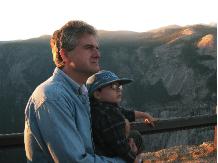
Martin Carey grew up as an Adventist in many different places, including Washington D.C., Missouri, and Guam, USA. During daylight hours he works as a psychologist for a high school in San Bernardino, California. He is also a licensed family therapist. He is married to Sharon, and has two sons, Matthew, 7, and Nick, 21. He continues to search for clear, dark skies with seven different telescopes up to 20 inches. The study of intelligent design takes up his remaining energy. You may contact him at martincarey@sbcglobal.net.
